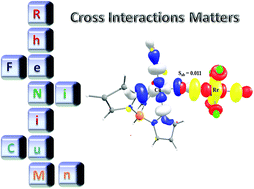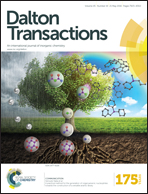Theoretical insights into the origin of magnetic exchange and magnetic anisotropy in {ReIV–MII} (M = Mn, Fe, Co, Ni and Cu) single chain magnets†
Abstract
Density functional calculations have been performed on a series of {ReIV–MII} (M = Mn(1), Fe(2), Co(3), Ni(4), Cu(5)) complexes to compute the magnetic exchange interaction between the ReIV and MII ions, and understand the mechanism of magnetic coupling in this series. DFT calculations yield J values of −5.54 cm−1, +0.44 cm−1, +10.5 cm−1, +4.54 cm−1 and +19 cm−1 for complexes 1–5 respectively, and these estimates are in general agreement with the experimental reports. Using molecular orbital (MO) and overlap integral analysis, we have established a mechanism of coupling for a {3d–5d} pair and the proposed mechanism rationalises both the sign and the magnitude of J values observed in this series. Our proposed mechanism of coupling has five contributing factors: (i) (Re)dyz–dyz(3d) overlap, (ii) (Re)dxz–dxz(3d) overlap, (iii) (Re)dxy–dxy(3d) overlap, (iv) (Re)eg–t2g(3d) overlaps and (v) (Re)eg–eg(3d) overlaps. Here, the first two terms are found to contribute to the antiferromagnetic part of the exchange, while the other three contribute to the ferromagnetic part. The last two terms correspond to the cross-interactions and also contribute to the ferromagnetic part of the exchange. A record high ferromagnetic J value observed for the {ReIV–CuII} pair in complex 5 is found to be due to a significant cross interaction between the dz2 orbital of the ReIV ion and the dx2−y2 orbital of the Cu(II) ion. Magneto-structural correlations are developed for Re–C and M–N bond lengths and Re–C–N and M–N–C bond angles. Among the developed correlations, the M–N–C bond angle is found to be the most sensitive parameter which influences the sign and strength of J values in this series. The J values are found to be more positive (or less negative) as the angle increases, indicating stronger ferromagnetic coupling at linear M–N–C angles. Apart from the magnetic exchange interaction, we have also estimated the magnetic anisotropy of [ReCl4(CN)2]2− and [(DMF)4(CN)MII(CN)] (MII–FeII, CoII and NiII) units using the state-of-the-art ab initio CASSCF/PT2/RASSI-SO/SINGLE_ANISO approach. The calculated D and E values for these building units are found to be in agreement with the available experimental results. Particularly a large positive D computed for the [ReCl4(CN)2]2− unit was found to arise from dxz/dyz → dxy excitations corresponding to the low-lying doublet states. Similarly, a very large positive D value computed for FeII and CoII units are also rationalised based on the corresponding ground state electronic configurations computed. The non-collinearity of the ReIV ion and the MII ion axial anisotropy (DZZ) axis are found to diminish the anisotropy of the building unit, leading to the observation of moderate relaxation barriers for these molecules.


 Please wait while we load your content...
Please wait while we load your content...